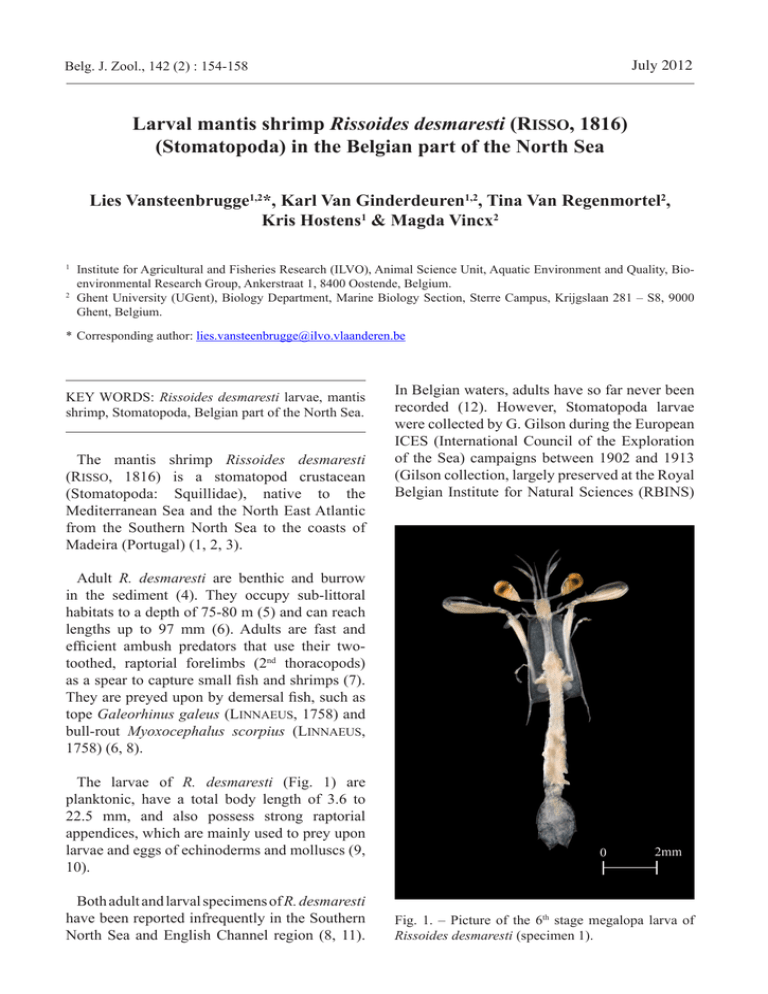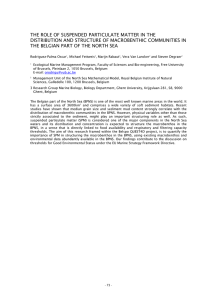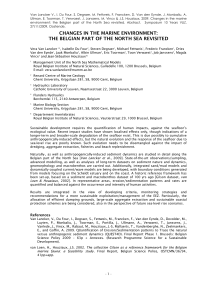Rissoides desmaresti , 1816) Lies Vansteenbrugge
advertisement

July 2012 Belg. J. Zool., 142 (2) : 154-158 Larval mantis shrimp Rissoides desmaresti (Risso, 1816) (Stomatopoda) in the Belgian part of the North Sea Lies Vansteenbrugge1,2*, Karl Van Ginderdeuren1,2, Tina Van Regenmortel2, Kris Hostens1 & Magda Vincx2 Institute for Agricultural and Fisheries Research (ILVO), Animal Science Unit, Aquatic Environment and Quality, Bioenvironmental Research Group, Ankerstraat 1, 8400 Oostende, Belgium. 2 Ghent University (UGent), Biology Department, Marine Biology Section, Sterre Campus, Krijgslaan 281 – S8, 9000 Ghent, Belgium. 1 * Corresponding author: lies.vansteenbrugge@ilvo.vlaanderen.be KEY WORDS: Rissoides desmaresti larvae, mantis shrimp, Stomatopoda, Belgian part of the North Sea. The mantis shrimp Rissoides desmaresti (Risso, 1816) is a stomatopod crustacean (Stomatopoda: Squillidae), native to the Mediterranean Sea and the North East Atlantic from the Southern North Sea to the coasts of Madeira (Portugal) (1, 2, 3). In Belgian waters, adults have so far never been recorded (12). However, Stomatopoda larvae were collected by G. Gilson during the European ICES (International Council of the Exploration of the Sea) campaigns between 1902 and 1913 (Gilson collection, largely preserved at the Royal Belgian Institute for Natural Sciences (RBINS) Adult R. desmaresti are benthic and burrow in the sediment (4). They occupy sub-littoral habitats to a depth of 75-80 m (5) and can reach lengths up to 97 mm (6). Adults are fast and efficient ambush predators that use their twotoothed, raptorial forelimbs (2nd thoracopods) as a spear to capture small fish and shrimps (7). They are preyed upon by demersal fish, such as tope Galeorhinus galeus (Linnaeus, 1758) and bull-rout Myoxocephalus scorpius (Linnaeus, 1758) (6, 8). The larvae of R. desmaresti (Fig. 1) are planktonic, have a total body length of 3.6 to 22.5 mm, and also possess strong raptorial appendices, which are mainly used to prey upon larvae and eggs of echinoderms and molluscs (9, 10). Both adult and larval specimens of R. desmaresti have been reported infrequently in the Southern North Sea and English Channel region (8, 11). Fig. 1. – Picture of the 6th stage megalopa larva of Rissoides desmaresti (specimen 1). Larval Rissoides desmaresti in the Belgian Part of the North Sea in Brussels, Belgium). Several specimens that were identified as Erichthus larvae were reidentified in the 1960s as larvae of Squilla desmaresti (11), nowadays renamed to Rissoides desmaresti (13). An overview of these findings is shown in Figure 2. Some other specimens could not be re-identified as they were absent from the Gilson collection, but are likely to be larvae of R. desmaresti. The latter are presented as ‘Erichthus’ observations in Figure 2. Larvae of R. desmaresti have been found all over the Belgian part of the North Sea (BPNS) area. However, since the early 1900s, no more recordings of R. desmaresti larvae were made or could be uncovered for the BPNS, not even in more recent hyperbenthic and zooplanktonic studies performed in this area (14, 15). Almost a century later, in August and September 2011, five larval R. desmaresti specimens were caught during zooplankton sampling campaigns in the BPNS on board RV Zeeleeuw. Four larvae were found at monitoring station W09 (N 51°45’ E 2°42’) situated north of ‘Hinderbanken’ and one at ‘Thornton bank’ monitoring station W07tris (N 51° 31.72’ E 2° 52.44’) (Fig. 2). A WP3 net (mesh size 1000 µm, Ø 1 m) was employed to collect the zooplankton samples. The net was trawled at a speed of approximately three knots, filtering the water column four times from surface to bottom in an undulating haul. Zooplankton samples were preserved in 4% buffered formaldehyde and analysed in the laboratory, using a stereomicroscope. 155 The larvae that were re-identified from the Gilson collection were also caught in August and September, but belonged to different developmental stages, ranging from 2nd megalopa to postlarval stage (Table 2). The duration of larval development in R. desmaresti has not thoroughly been investigated yet. However, there are similarities with other Squillidae, in particular Squilla mantis (Linnaeus, 1758). In late autumn and winter, female mantis shrimp prepare for reproduction, but spawning only happens in spring (mid-March – mid-April) (6, 9). After a ten-week incubation period (as in S. mantis), stage 1 megalopa larvae of R. desmaresti should be present in the water in June or July. Stage 8 and 9 larvae should show up in the plankton between August and October (8-12 weeks later, just as in S. mantis), which is consistent with our findings for R. desmaresti (Table 2). Hereafter, The larval morphology of R. desmaresti can easily be distinguished from another Stomatopoda species Platysquilla eusebia (Risso, 1816) that is also found in the North Sea, by comparing the shapes of the carapax and telson (9, 11). During larval development nine megalopa stages can be morphologically distinguished (9). The three specimens collected in August could be allocated to the 6th and 7th stage, the two specimens caught in September to the 8th stage. Examined identification characteristics are listed in Table 1. Fig. 2. – Spatial distribution of larval Rissoides desmaresti in the Belgian part of the North Sea. Triangles (▲) indicate recent observations; circles (●) indicate observations by Gilson from the early 1900s. Note: Coordinates of stations labeled ‘X’ are estimations based on descriptions in van der Baan & Holthuis (11). 156 L. Vansteenbrugge, K. Van Ginderdeuren, T. Van Regenmortel, K. Hostens & M. Vincx Table 1 Examined identification characteristics for the five collected specimens (verified with Giesbrecht (9)), A= antenulla, B= basis, I= ischium, T1= 1st thoracopod or ‘cleaning leg’, T2= 2nd thoracopod or raptorial leg, T3 – T5= 3rd – 5th thoracopod, na= not applicable, + = present, - = absent. Characteristics Spec 1 Spec 2 Spec 3 Spec 4 Spec 5 Location W07tris W09 W09 W09 W09 3 Aug 2011 3 Aug 2011 3 Aug 2011 2 Sep 2011 2 Sep 2011 85 242 242 483 483 Date of collection Filtered volume (m³) Density (ind/m³) 0.012 --------0.008-------- --------0.004-------- Length (rostrum-telson) (mm) 10.7 11.4 10.8 17.0 17.0 # articles dorsal flagellum of A 2 2 3 8 8 # articles ventral flagellum of A 1 1 2 4 4 Ratio width and length telson na na 4:5 na na Ratio B + I of T3 and B of T2 2:7 2:7 1:2 >3:4 >3:4 Gills of T3 na na + na na Gills of T4 na na + na na Gills of T5 na na - na na Gills T1 equal in size as gills T2 na na na yes yes Larval development stage 6 6 7 8 8 the larva undergoes metamorphosis (four postlarval stages were described by Giesbrecht (9)), which results in a pubescent adult living in and on the sediment (duration approximately 2-3 months) (6). It is unclear how the larvae of R. desmaresti arrived in the BPNS. Adult Stomatopoda have never been observed in the BPNS despite regular benthic monitoring campaigns with Van Veen grabs and an 8 m shrimp trawl (mesh size 20 mm in the cod end) since the late 1970s (12). Benthic specialists were addressed, but none of them could confirm an observation in the BPNS. However, adults were recently observed at the east, south (including English Channel area) and west coast of the UK by divers and in beam trawl and grab samples (4, 8, 16). There are a few observations in the Dutch part of the North Sea from the early 1900s (11) and a few recent unpublished observations. The Southern North Sea is known as the northern boundary of the distribution range for R. desmaresti. The northernmost sighting of an adult was offshore from the Dutch Wadden islands (N 53°42’ E 3°52’) on 31 January 1963 (11). Since dominant surface currents run in a north easterly direction, larvae might be transported to the BPNS and beyond from populations in the English Channel and the south coast of the UK (17). Increase in sea water temperature due to global warming might favour this larval transport and survival. The absence of adult Stomatopoda in the BPNS is probably also related to the lack of suitable habitat. Adults require a particular sediment Larval Rissoides desmaresti in the Belgian Part of the North Sea 157 Table 2 Overview of larval stages of Rissoides desmaresti found in the Belgian part of the North Sea (M = megalopa, PL = postlarva), recent observations are marked in bold. Station Date X2_1904 B9_1905 X1_1906 B1_1908 X5_1908 X3_1908 X4_1908 B9_1909 B2_1912 W07tris W09_Aug W09_Sept 29/08/1904 25/08/1905 23/08/1906 25/08/1908 1/09/1908 16/09/1908 23/09/1908 22/08/1909 25/08/1912 6/08/2011 7/08/2011 8/09/2011 M1 M2 M3 1 composition (a mixture of mud, sand and gravel) to construct a U-shaped burrow, while they avoid sites with either high mud concentration (> 70%) or sandy sediments with very low mud concentrations (≤ 2%) (4). The BPNS is characterised by mixed sediments, but only the nearshore area (overlapping with the Abra alba benthic community (18, 19)) contains enough mud to construct cohesive burrows (20). Together with disturbance by ubiquitous demersal fishing activities, the current lack of a proper gravel concentration in the sediment mixture probably prevents the settlement of stable R. desmaresti populations. In conclusion, this manuscript describes five new recordings of larvae of the mantis shrimp Rissoides desmaresti in the Belgian part of the North Sea, which are the first recordings since the early 1900s. The species R. desmaresti and the order Stomatopoda can now be added to the Belgian marine species list (12). The larvae were most probably transported with the currents through the English Channel, possibly favoured by global sea water temperature increase. Larval stages M4 M5 M6 1 6 1 9 1 1 M7 M8 M9 2 14 1 1 1 2 1 1 PL 1 ACKNOWLEDGEMENTS The authors wish to thank André Cattrijsse and Michiel Tjampens of the Flanders Marine Institute (VLIZ) and the crew of the research vessel Zeeleeuw. Special thanks to Vera Van Lancker, Annelies De Backer, Gert Van Hoey, Sofie Vandendriessche, Hans Hillewaert, Jan Wittoeck and Ellen Pecceu for valuable input to the manuscript. REFERENCES 1. 2. 3. Manning RB (1977). A monograph of the West African stomatopod Crustacea. Atlantide Report, 12: 25-181. Biscoito MJ (1985). An account of the stomatopod crustaceans of Madeira. Boletim do Museu Municipal Funchal, 37: 158-174. Lewinsohn C & Manning RB (1980). Stomatopod Crustacea from the Eastern Mediterranean. Smithsonian Contributions to Zoology, 305: 1-22. 158 L. Vansteenbrugge, K. Van Ginderdeuren, T. Van Regenmortel, K. Hostens & M. Vincx 4. Ramsay K & Holt RHF (2001). Mantis shrimps Rissoides desmaresti in Tremadog Bay, North Wales. Journal of the Marine Biological Association of the UK, 81: 695-696. 5. Manning RB & Froglia C (1979). Description of a new Allosquilla with notes on other Adriatic stomatopod Crustacea. Quaderni del Laboratorio di Tecnologia della Pesca, 2 (4): 177-190. 6. Herbert RJH (2011). Performance and habitat of the mantis shrimp Rissoides desmaresti (Stomatopoda: Squillidae) near the range border on the south coast of England. Journal of Crustacean Biology, 31: 416-423. 7. Caldwell RL & Dingle H (1976). Stomatopods. Scientific American, 234: 80-89. 8. Griffin R, Herbert RJH & Pearce B (2011). New UK recordings of the mantis shrimp, Rissoides desmaresti (Crustacea: Stomatopoda), provided by broad-scale mapping projects. Marine Biodiversity Records, 4: 1-4. 9. Giesbrecht W (1910). Stomatopoden, Erster Theil. Fauna und Flora des Golfes von Neapel und der Angrenzenden Meeres-Abschnitte. R. Friedländer & Sohn, Berlin. 10. Gohar HAF & Al-Kholy AA (1957). The larval stages of the three stomatopod Crustacea. Publications of the Marine Biological Station, Al-Ghardaqa, Egypt, 9: 85-130. 11. van der Baan SM & Holthuis LB (1966). On the occurrence of Stomatopoda in the North Sea, with special reference to larvae from the surface plankton near the lightship Texel. Netherlands Journal of Sea Research, 3: 1-12. Belgian Marine Species 12. VLIZ Consortium (2010). The Belgian Register of Marine Species (Internet address: http://www. marinespecies.org/berms). 13. Manning RB & Lewinsohn C (1982). Rissoides new genus of stomatopod crustacean from the East Atlantic and South Africa. Proceedings of the Biological Society of Washington, 95: 352353. 14. Dewicke A, Cattrijsse A, Mees J & Vincx M (2001). Spatial patterns of the hyperbenthos of subtidal sandbanks in the southern North Sea. Journal of Sea Research, 49: 27-45. 15. Van Ginderdeuren K, Fiers F, De Backer A, Vincx M & Hostens K (2012). Updating the zooplankton species list for the Belgian part of the North Sea. Belgian Journal of Zoology, 142: 3-22. 16. Martin J (2011). Les invertébrés marins du golfe de Gascogne à la Manche orientale. Editions Quae, France. 17. Verwey J (1966). The origin of the stomatopod larvae of the Southern North Sea. Netherlands Journal of Sea Research, 3: 13-20. 18. Van Hoey G (2004). Macrobenthic community structure of soft-bottom sediments at the Belgian Continental Shelf. Estuarine, Coastal and Shelf Science, 59: 599-613. 19. Degraer S, Verfaille E, Willems W, Adriaens E, Vincx M, Van Lancker V (2008). Habitat suitability modelling as a mapping tool for macrobenthic communities: An example from the Belgian part of the North Sea. Continental Shelf Research, 28: 369-379. 20. Van Lancker V, Du Four I, Verfaillie E, Deleu S, Schelfaut K, Fettweis M, Van den Eynde D, Francken F, Monbaliu J, Giardino A, Portilla J, Lanckneus J, Moerkerke G & Degraer S (2007). Management, research and budgetting of aggregates in shelf seas related to end-users (Marebasse). Final Scientific Report. Belgian Science Policy, 139pp. Received: July 19th, 2012 Accepted: October 5th, 2012 Branch editor: De Troch Marleen





